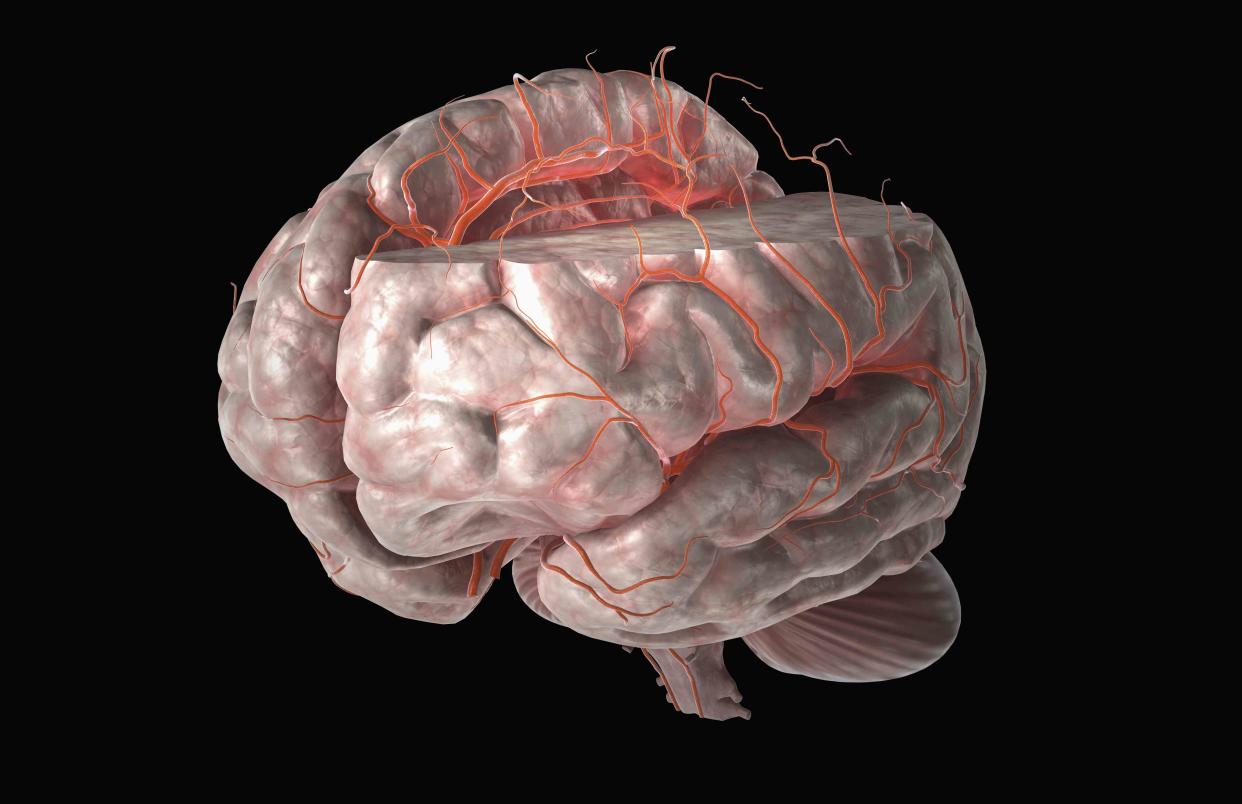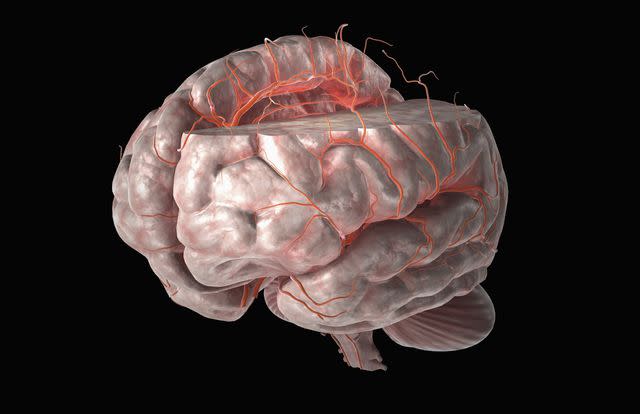Middle Cerebral Artery Stroke Causes, Symptoms, and Treatment

Medically reviewed by Nicholas R. Metrus, MDFact checked by Nick Blackmer
A middle cerebral artery (MCA) stroke occurs when blood flow from the largest artery of the brain is suddenly interrupted (ischemia) or altogether stopped (infarction). The loss of blood flow causes tissue death, leading to serious and potentially permanent brain injury.
MCA strokes are most often the result of a blood clot that travels from outside the brain, such as from the heart or carotid artery, and causes a partial or complete blockage of the artery.
While an MCA stroke is serious, people suffering one are more likely to survive than someone with a hemorrhagic stroke, which is caused by a ruptured artery.
This article takes a closer look at the MCA as well as the symptoms and causes of MCA strokes. Is also explains how MCA strokes are diagnosed and treated and what to expect during rehabilitation.

What Is the Middle Cerebral Artery?
The arteries in your brain come in symmetrical pairs. Each one has a left and right artery. The MCAs are vital blood vessels that branch off from the internal carotid arteries.
The internal carotid arteries are branches of the common carotid arteries. Those are large blood vessels in your neck.
The MCA is the largest branch of the internal carotid arteries. It can be involved in large strokes.
What Does the MCA Do?
Arteries in the brain carry blood that’s rich in oxygen and nutrients to the brain. Each artery supplies a different section of the brain. That section is called the “territory” of that artery.
The MCAs supply a large territory in the brain that includes the:
Parietal lobe: Processes sensory information related to touch, taste, and temperature
Temporal lobe: Processes audio and encodes memory
Internal capsule: Aids communication between areas of the brain
A portion of the frontal lobe: Important for movement, expressive language, and the ability to work toward a goal
When blood flow to these areas is impaired, they have a hard time doing their jobs.
Related: Middle Cerebral Artery Anatomy and Function
Recap
MCA strokes happen when the MCA is blocked or ruptured and blood flow to the MCA’s territory is interrupted.
The MCA is the largest branch of the internal carotid arteries. It carries blood—which contains oxygen and nutrients—to several critical areas of the brain. The lack of blood flow kills brain cells and impairs function in that region.
MCA Stroke Symptoms
MCA strokes are the most common type. Their symptoms are the ones people usually associate with strokes, such as:
Weakness and/or numbness on one side
Facial droop
An MCA stroke may also cause:
Sensory deficits
Visual defects
These affect the opposite side of the body from the artery. So a stroke in the right MCA causes symptoms on the left side of the body.
Related: How to Recognize a Stroke and What to Do
This video has been medically reviewed by Chris Vincent, MD.
Causes
The MCA is a large blood vessel. Large-vessel strokes affect more of the brain than strokes in small vessels. If the MCA itself is blocked, the result is a large-vessel stroke that affects its entire territory.
If only a small branch of the MCA is blocked, it causes a small-vessel stroke. This impacts a small section of the MCA’s territory and is often less serious.
MCA strokes are generally caused by a blood clot that travels from outside the brain. Typically, it’s from the heart or carotid artery. Then the clot gets lodged in the MCA and blocks blood flow.
This is called an embolic stroke. When the clot originates in the arteries of the brain, it’s called thrombotic.
Risk factors for MCA strokes include:
Heart disease
Carotid artery disease
General stroke risk factors such as high cholesterol, hypertension, and diabetes
Recap
MCA strokes are common and their symptoms are well known. A stroke in the left MCA causes symptoms on the right side of your body and visa-versa.
Large-vessel strokes like MCA strokes affect large areas of the brain. Sometimes, only a branch of the MCA is blocked and the stroke is less severe.
Blood clots that travel from the heart or carotid artery often cause MCA strokes.
Diagnosis
MCA strokes are among the most easily recognized types of stroke.
Even so, your healthcare provider will likely use multiple labs and tests to confirm the diagnosis. These may include:
A neurological exam to determine affected brain regions
Electrocardiogram (EKG) to check electrical conduction of the heart, which may be irregular after a stroke
Lumbar puncture (spinal tap) to check for hemorrhagic stroke (rupture of a weakened blood vessel)
Blood tests to look for known risk factors, including clotting disorders, high cholesterol, and diabetes
Computed tomography (CT) scan to quickly check for a brain bleed
Magnetic resonance imaging (MRI) to find a blood vessel blockage
Other tests and imaging may be performed depending on your symptoms.
Treatment and Rehabilitation
Urgent treatment may include:
Tissue plasminogen activator (TPA), a powerful blood thinner
Other blood thinners
Careful management of blood pressure, blood sugars, electrolytes, and fluids
Surgery to remove pressure on vital brain regions
Rehabilitation after a stroke can be intensive and prolonged. It may involve physical, occupational, and speech therapy.
Summary
Blocks or ruptures in the MCA lead to MCA strokes. The resulting loss of blood, oxygen, and nutrients can cause brain damage and impair function in the regions that get blood from the MCA.
MCA strokes are often large unless only a branch of it is blocked, in which case they’re smaller and less serious. Symptoms of MCA strokes are the ones most people associate with strokes and have to do with the regions affected.
MCA strokes are often caused by blood clots that travel from the heart or carotid artery. They’re diagnosed using a neurological exam, blood tests, and imaging.
Treatment includes blood thinners, surgery to relieve pressure, and management of several vital signs. Recovery may involve multiple types of therapy, depending on the symptoms. Recovery from an MCA stroke may take some time, particularly if the entire MCA was blocked, resulting in a large stroke.
Long-term recovery and rehabilitation may take months or even years. However, a good recovery is possible even from very serious strokes. Most people who have an MCA stroke are able to regain some function.
Frequently Asked Questions
What is a middle cerebral artery stroke?
A middle cerebral artery stroke occurs when the middle cerebral artery (the largest branch of the internal carotid artery) is blocked. The middle carotid artery supplies parts of the brain responsible for movement and feeling in the trunk, limbs, and face.
What are symptoms of a middle cerebral artery stroke?
Middle cerebral artery (MCA) strokes cause the same symptoms that people commonly associate with any stroke, namely:
Unilateral (one-sided) weakness and/or numbness
Unilateral facial drooping
Unilateral vision changes
Difficulty speaking
Loss of ability to understand or express speech
What causes a middle cerebral artery stroke?
A middle cerebral stroke can either be hemorrhagic (caused by a brain bleed) or ischemic (caused by a blockage). Older age, genetics, race, high blood pressure, smoking, obesity, and diet contribute to both. Risk factors for an ischemic stroke also include high cholesterol, diabetes, coronary artery disease, heart failure, and atrial fibrillation.
How is a middle cerebral artery stroke diagnosed?
The diagnosis starts with either a computed tomography (CT) or magnetic resonance imaging (MRI) scan of the brain, followed by a CT or MR angiogram of the head and neck. Lab tests may be performed as well as other diagnostic procedures such as an electrocardiogram (ECG) or thoracic echocardiogram.
How do you treat a middle cerebral artery stroke?
In the event of an ischemic stroke, an intravenous drug called tissue plasminogen activator (TPA) is used to break up the clot blocking the artery; in some cases, catheters and stents may be used to remove the clot and restore blood flow. Hemorrhagic strokes usually require surgery to relieve intracranial pressure caused by bleeding.
How do you know if you are having a stroke?
The acronym BE FAST is often used by health educators to describe stroke symptoms affecting balance, eyes, face, arm, speech, and time. Call 911 or seek emergency care if you or someone else experiences:
Sudden loss of balance on one side
Vision changes in one eye or double vision
One-sided facial drooping
Loss of function or sensation in one arm
Slurred speech
Trouble finding a word or getting words out

